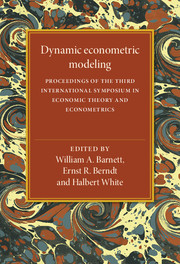 Dynamic Econometric Modeling
Dynamic Econometric Modeling Book contents
- Frontmatter
- Contents
- Editors' introduction
- List of contributors
- Part I Dynamic structural modeling
- Part II Linear time series modeling
- Part III Chaotic attractor modeling
- Part IV Applications
- 13 Investment and sales: some empirical evidence
- 14 Me and my shadow: estimating the size of the U.S. hidden economy from time series data
- 15 Estimating structural models of unemployment and job duration
14 - Me and my shadow: estimating the size of the U.S. hidden economy from time series data
Published online by Cambridge University Press: 03 May 2010
- Frontmatter
- Contents
- Editors' introduction
- List of contributors
- Part I Dynamic structural modeling
- Part II Linear time series modeling
- Part III Chaotic attractor modeling
- Part IV Applications
- 13 Investment and sales: some empirical evidence
- 14 Me and my shadow: estimating the size of the U.S. hidden economy from time series data
- 15 Estimating structural models of unemployment and job duration
Summary
Introduction
In the last few years a growing concern over the phenomenon of the shadow (or hidden) economy has arisen, and as a consequence this topic has received increased attention among public officials, politicians, and social scientists. For the United States, like many other industrial countries, there are several important reasons why politicians and the public in general should be concerned about the growth and size of the shadow economy. Among the most important of these are:
If an increase in the size of the shadow economy is mainly caused by a rise in the tax burden, an increased tax rate may lead to a decrease in tax receipts and thus further increase the budget deficit.
If economic policy measures are based on mistaken “officially measured” indicators (such as unemployment), these measures may be at least of a wrong magnitude. In such a situation a prospering shadow economy may cause a severe problem for political decision makers because it leads to quite unreliable officially measured indicators, so that even the direction of intended policy measures may be questionable.
The rise of the shadow economy can be seen as a reaction of individuals to their overburdening by state activities (such as high taxes and an increasing number of state regulations).
Information
- Type
- Chapter
- Information
- Dynamic Econometric ModelingProceedings of the Third International Symposium in Economic Theory and Econometrics, pp. 297 - 334Publisher: Cambridge University PressPrint publication year: 1988
Accessibility standard: Unknown
Why this information is here
This section outlines the accessibility features of this content - including support for screen readers, full keyboard navigation and high-contrast display options. This may not be relevant for you.Accessibility Information
- 22
- Cited by